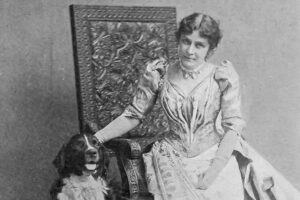by Gudrun Hutchins
Irish physicist John Tyndall is commonly credited with discovering the greenhouse effect which underpins the science of climate change. Starting in 1859, he published a series of studies on the way greenhouse gases including carbon dioxide trap heat in the Earth’s atmosphere.
However, a recently digitized copy of The American Journal of Science and Arts from 1856 proves that a woman beat him to the concept that the presence of carbon dioxide in the atmosphere is associated with global warming.
Eunice Foote conducted a series of experiments that demonstrated the interactions of the sun’s rays on different gases. She used an air pump, mercury thermometers, and two long glass cylinders. First she placed thermometers in each cylinder, then by using an air pump, she evacuated the gas from one cylinder and compressed it in the other. After allowing both cylinders to reach the same temperature, she placed the cylinders in bright sunlight and measured temperature variance under different moisture and heat conditions. She performed this experiment with carbon dioxide, common air, and hydrogen. Of the gases she tested, Foote concluded that carbon dioxide trapped the most heat, reaching a temperature of 125°F. From this experiment, she stated “the receiver containing this gas became itself much heated … and it was many times as long in cooling.”
Looking to the history of the Earth, Foote theorized that “An atmosphere of that gas would give to our earth a high temperature; and if, as some suppose, at one period of its history, the air had mixed with it a larger proportion than at present, an increased temperature from its own action, as well as from increased weight, must have necessarily resulted.”
Eunice Foote was the first scientist known to have experimented on the warming effect of sunlight on different gases. However, she did not have the laboratory equipment to quantize her work or the mentors to promote it. Her apparatus was invented in 1770 by de Saussure and her work was effectively “lost” because nearly all scientific research in physics and chemistry was performed in Europe during the nineteenth century. There was no reason for European physicists to consult American Journals.
Foote illustrated her findings in a paper entitled, Circumstances Affecting the Heat of the Sun’s Rays, which was accepted at the eighth annual meeting of the American Association for the Advancement of Science on August 23, 1856 in Albany, NY. Even though women were in principle allowed to speak at the conference, her paper was read by Professor John Henry of the Smithsonian Institution. Before reading Foote’s work, Henry introduced the findings by stating “Science is of no country and of no sex. The sphere of woman embraces not only the beautiful and the useful, but the true.” Foote’s paper was published later the same year under her name in the American Journal of Science and Arts.
Foote also worked on electrical excitation of gases and, in August 1857, her work was published in the Proceedings of the American Association for the Advancement of Science. She also received a patent in 1860 for a “filling for soles of boots and shoes” made of “one piece, of vulcanized India-rubber” to “prevent the squeaking of boots and shoes.”
In addition, in 1867 Foote developed a new paper-making machine that produced paper described as being “a marked improvement on the ordinary sorts in respect to strength, smoothness and facility for tearing evenly.”
It is not at all obvious why Foote performed these experiments. At the time, she was the wife of Elisha Foote and the mother of two children. She was also described as “as a fine portrait and landscape painter.” Her interest in science was honed during her education at Troy Female Seminary, later renamed the Emma Willard School. Students at the Seminary were permitted to attend a nearby science college, which was where Foote learned foundational chemistry and biology. She was influenced by the textbooks of Almira Hart Lincoln Phelps, Emma Willard’s sister, who was a female pioneer of women in science and the third female member of the American Association for the Advancement of Science.

Eunice Foote
Eunice Foote was also a suffragist. Both Eunice and her husband Elisha Foote lived in Seneca Falls for a decade after their marriage in 1841 and both attended the 1848 Seneca Fall Convention and were signatories to the convention’s Declaration of Sentiments. Eunice was one of the five women who prepared the proceedings of the convention for publication.
In 2010, retired petroleum geologist Ray Sorenson came across Foote’s work in an 1857 volume of Annual Scientific Discovery. He quickly realized that Foote was the first to make the connection between carbon dioxide and climate change and that her work had gone unrecognized. In November 2019 at the University of California, Santa Barbara, a lecture and library exhibit recognized Foote’s contribution to climate science and her omission from the history of the field. John Perlin, a research scholar in the Department of Physics at the same university is writing a book about Foote to make evident Foote’s importance in understanding the greenhouse effect. He hopes to help restore her place among other early pioneers of climate science, such as John Tyndall and Svante Arrhenius.
” target=””]Return to “Celebrating the Accomplishments of Women” Return to “Celebrating the Accomplishments of Women”Return to Table of Contents
